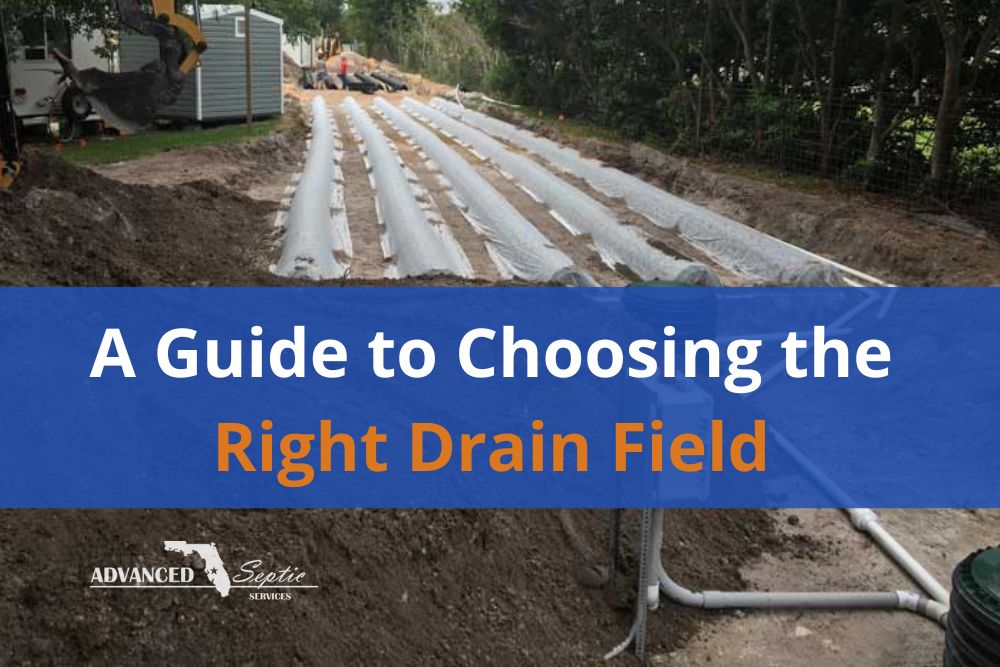A well-functioning septic system depends on more than just the tank; the drain field is critical in wastewater treatment.
The drain field, also known as the leach field, disperses treated effluent into the surrounding soil. For Florida homeowners, choosing a drain field requires careful consideration of soil types, water table levels, and household size. Let’s explore the types of drain fields available and their suitability for Florida’s unique soil conditions.

Why Is Choosing a Drain Field Important?
The drain field’s primary function is to filter and safely dispose of wastewater. A poorly designed or mismatched drain field can lead to problems like groundwater contamination, system backups, or premature failure. When choosing a drain field, factors such as soil permeability, property layout, and environmental regulations come into play. These considerations are even more critical in Florida, where soil and groundwater conditions vary significantly.
Types of Drain Fields for Septic Systems
When choosing a drain field, each type has specific characteristics suited to different soil conditions and site constraints.
1. Conventional Drain Field
A conventional drain field consists of a series of trenches filled with gravel or crushed stone. These trenches are topped with soil and connected to the septic tank via perforated pipes. Effluent from the tank flows into the trenches and gradually seeps into the surrounding soil.
Best Suited For: Sandy soils with good drainage, common in many parts of Florida.
Advantages: Affordable and relatively easy to install.
Considerations: Not ideal for properties with high water tables or clay-heavy soil, as these conditions impede drainage.
2. Chamber System
Chamber systems use large, open-bottomed plastic chambers instead of gravel. The chambers create a void for effluent to flow and disperse into the surrounding soil.
Best Suited For: Areas with moderate soil permeability or where gravel is hard to source.
Advantages: More adaptable to fluctuating wastewater loads and easier to install in tight spaces.
Considerations: Slightly higher upfront costs compared to conventional systems.
3. Mound System
A mound system is an elevated drain field created by adding layers of sand and gravel to the existing soil. After leaving the septic tank, wastewater (effluent) is sent into the mound, filtering through the materials before reaching the natural soil.
Best Suited For: Areas with high water tables, shallow bedrock, or poorly draining clay soils.
Advantages: Effective in preventing groundwater contamination in challenging soil conditions.
Considerations: Requires more space and routine maintenance.
4. Drip Distribution System
A drip distribution system uses a network of small-diameter pipes to evenly distribute effluent across the drain field. The pipes are buried below the surface and connected to a pump, ensuring precise delivery.
Best Suited For: Sites with limited space or uneven terrain.
Advantages: Highly efficient and reduces the risk of system overload.
Considerations: Requires advanced technology and higher upfront costs.
5. Aerobic Treatment Unit (ATU) with Drain Field
An ATU treats wastewater more thoroughly than a conventional septic tank, meaning less treatment must occur via natural processes in the leach field. The effluent is dispersed through a smaller drain field, often using shallow trenches or drip irrigation.
Best Suited For: Small lots, environmentally sensitive areas, or properties near water bodies.
Advantages: Reduces the size of the drain field and improves water quality.
Considerations: Higher maintenance and operational costs due to electricity usage.
Florida Soil Considerations for Choosing a Drain Field
Florida’s diverse soil conditions make choosing a drain field more complex than in other states. Here’s how soil factors influence your decision:
Sandy Soils: Sandy soils are found in coastal areas and much of central Florida, and they drain quickly, making them ideal for conventional and chamber systems.
Clay Soils: Predominant in northern Florida, clay soils have poor drainage and require solutions like mound systems or drip distribution systems.
High Water Tables: Common in southern and Central Florida, high water tables necessitate elevated systems like mounds or ATUs to prevent contamination.
Karst Topography: Areas with limestone bedrock, such as those near springs, require advanced treatment systems to protect groundwater.
Conducting a professional soil test is crucial when choosing a drain field for your property. The most suitable system is determined by soil permeability, water table depth, and restrictive layers like clay or rock.
Regulatory Considerations in Florida
Florida has stringent regulations governing septic systems to protect its fragile ecosystems. When choosing a drain field, homeowners must comply with Florida Department of Health guidelines. These regulations include setback requirements from water bodies, minimum drain field sizes, and approved treatment methods for high-risk areas.
Working with a licensed septic professional ensures compliance and helps you navigate the permitting process. They can also help design a system tailored to your property’s unique needs.

